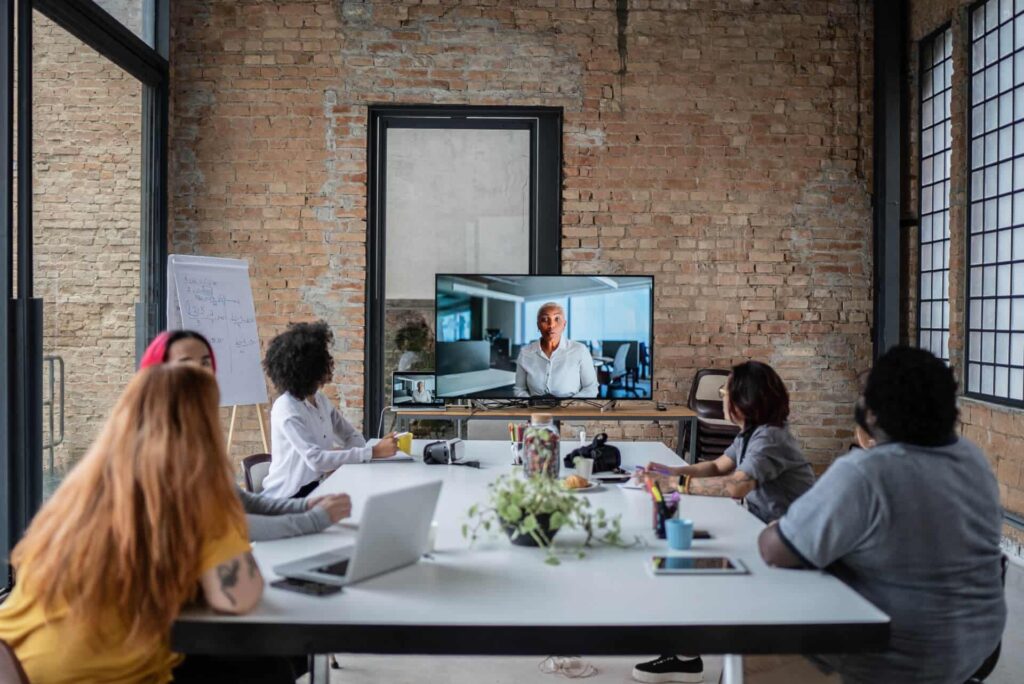Hybrid work requires good hybrid leadership to be successful. This may seem obvious. But in the pressure to get things right, companies tend to focus more on hybrid employees and their hybrid schedules, and on areas like hybrid workplace technology and workplace transformation.
Meanwhile, without responsive leadership at the top to navigate all these hybrid workplace change strategies, companies can easily struggle with all the challenges of hybrid working—without reaping any of the rewards.
With all the issues currently challenging not only businesses but the world at large, leaders matter more than ever. And hybrid leaders in particular need the right leadership skills and mindset to get things right.
In this article, we explore hybrid leadership. We look at 13 best practices every leader needs to keep top of mind to support workers and create a more productive, future-proof office.
The rise of a new way of working—and a new hybrid leadership style
By now, employees and employers alike have come to accept that the hybrid workplace will play a key role in the future of work.
While the Great Resignation has been rebranded (now sometimes called the ‘Great Reshuffle’ or the ‘Big Quit’), and while it doesn’t get the same press coverage it once did, make no mistake: we’re still in an employee’s job market.
Having a positive culture tops the list of what job-seekers today want in a new employer. This is followed closely by wellbeing benefits and a sense of purpose and meaning.
Moreover, all the latest research is showing that post-pandemic employees are putting their quality of life front and center in their career decisions. And ready to leave companies that don’t follow suit. People simply won’t settle for inflexible or toxic business leaders anymore. This fact is unlikely to change, even if market trends shift.
And ultimately, employees see a hybrid work environment as a means to an end. It’s not that they want hybrid work per se, but that they want autonomy and a good work-life balance.
“Talking to our client base,” Maya Ketter, OfficeSpace VP of Client Success, insists, “we see that employees don’t necessarily want to work remote. They want to be flexible, and they want to have that choice.”
The importance of flexibility
For all these reasons, workers today want flexibility in terms of when and where they work. This is putting pressure on companies and their leaders to not only embrace hybrid work, but to also improve the hybrid workplace experience.
And for all these reasons, while a hybrid leader is simply anyone leading hybrid teams, a good hybrid leader is one who understands that this new world of work is an opportunity to create a better work life for everyone.
“This is a pivotal moment, where leadership matters more than ever,” writes Jared Spataro in the Harvard Business Review. “Those who embrace a new mindset and shift cultural norms will best position their people and their business for long-term success.”
Hybrid leadership skills
Leadership has always been a science and an art, and a combination of hard and soft skills and emotional intelligence.
And it should go without saying that leadership has always been key to organizational culture.
But what about in a new hybrid world, where that organizational culture is in flux?
Employee survey after employee survey today show that what people are really craving from work is a good culture, enhanced workplace wellbeing, and empowerment in the workplace.
So hybrid leadership is not just a matter of choosing and implementing the right hybrid work model, installing the right workplace technology, and calling it a day.
How do you inspire every employee, and create equal opportunities for everyone? Or how do you help your people stay productive while avoiding burnout? What about fostering real connection between team members who may never meet face-to-face?
Researchers today believe that hybrid/remote leadership requires higher leadership KSA (knowledge, skills, and abilities) levels. Specifically, they need better communication and organizational skills, and more analytical and cognitive ability.
In other words, today’s hybrid leaders need to step up their game.
What is the difference between a ‘transactional’ and ‘transformational’ leader? Are there other hybrid leadership models?
‘Hybrid leadership’ is a very broad term. Like all leaders, those managing hybrid teams can be transactional or transformational, democratic or autocratic, coercive or coaching. The list goes on.
In a nutshell, a transactional leader is one who focuses on output and processes. A transformational leader focuses on inspiring people and employee engagement.
Of course, no leader is one-note. Particularly in a hybrid environment, leaders will likely find they have to continuously evolve and grow, relying on different styles and models.
In fact, researchers suggest that, given our new, dynamic world of work, “organizations are forced to examine not only traditional workplace models but also leadership models.” So even companies that cannot or will not adopt hybrid work may still want to consider improving their leadership development to keep up.
Note that Gartner has identified four types of hybrid work leaders today:
- Champions, who have the right mindset and skill set to lead hybrid teams
- Strivers, who have the right mindset but lack the right skill set
- Resistors, who have the right skill set but aren’t open to hybrid work
- Laggards, who have neither the right skills nor mindset to lead hybrid work
Note, too, that prior to this current boom in hybrid work, the term ‘hybrid leader’ was sometimes used to describe someone who blended the best of so-called ‘male’ and ‘female’ leadership styles.
Regardless of your definition, all leaders and especially those in complex new work environment types can benefit from the following best practices.

Hybrid workforce leadership: 13 best practices
Leadership has always been about balancing business demands with employee needs.
But how do you do this with a distributed workforce? How can a leader ensure everyone has the same employee experience and company touchpoints, when they’re not all on-site ?
Research suggests that virtual leadership requires all the traditional leadership competencies, along with “the amplified ability to communicate, an increased ability to communicate interdependently, increased organizational skills, analytical ability and most critically – cognitive ability.”
Of course, there’s a wide spectrum of hybrid work options now. And therefore a spectrum of hybrid leadership skills that will be needed for each team lead.
That said, the following best practices can help just about every type of hybrid leader in just about every type of hybrid setting.
1. Start with trust
Hybrid leaders need to remember the reason employees want hybrid in the first place. They want autonomy, they want flexibility, and they want a good work culture with effective hybrid leadership.
In other words, employees want to be trusted to be the responsible adults and workers that they are. But only 37% of employees believe their organizations actively empower teams to make their own decisions.
So leaders should follow best practices, set their teams up for success (specifically by providing clear guidelines and the necessary working tools), and then start assuming the best of their people. There will always be outliers. But hybrid leaders need to assume that their virtual teams are doing as much and as important work as in-office teams.
Remember that people have so much choice now when it comes to their careers. If they’ve stuck with you, it’s because they want to be with you.
“We have to trust and empower our people to make the right decision, and they will rise to the occasion,” says workplace strategist Angie Earlywine, Senior Director in the Total Workplace division of Global Occupier Services at Cushman & Wakefield. “I really hope we are past the days of ‘I don’t trust that my people are working because I can’t see them.’”
“If you lead from a trust-first perspective, people will do the right thing.”
Angie Earlywine, Cushman & Wakefield
2. Provide clear guidance
Despite all the benefits of working remotely, there’s no doubt that workdays are a lot less straightforward than they used to be.
There’s a big difference between our ‘new normal’ and the ‘old days, when everyone worked in the same seat in the same office, day after day. Leaders need to provide clear instructions and guidelines to everyone on their team, to help them navigate these new changes. Your team can’t possibly do all things you want them to do, unless you clearly state what those things are.
Specifically, employees will need to explicitly know:
- What is expected from them
- What they can expect from team leads
- How to use the physical office effectively
- How to use the digital workspace
- How to interact with communication technology (Should they be on Slack all day? Have their cameras on in Zoom meetings? Check in or respond to certain messages within a set time?)
- How to manage their personal hybrid work schedule (Are they expected to be in the office a certain number of days? How should they communicate when they’ll be in-office?)
Like OfficeSpace CEO David Cocchiara writes in Forbes, all this information can be in a formal guide, a microsite or through regular, on-going emails. The important thing is that “clear and constant communication can reduce the level of confusion employees may have and quell any uneasiness they may be feeling.”
Note that, as we’ll cover below, this may be an area where leadership collaborates with HR to ensure proper communication.
“Hybrid office workers will need a lot of help and guidance as they transition to flexible work and find their work-life balance.”
David Cocchiara, OfficeSpace Software
3. Set the right example as a hybrid leader
Hybrid leaders need to embrace the hybrid office and all aspects of hybrid working, if they want their employees to do the same.
No one likes hearing ‘do as I say, not as I do.’ And perhaps nothing will turn employees off coming into the office on a hybrid schedule, than if leadership never bothers to come in, either.
Likewise, leaders can’t expect their team to be on Slack all day, for example, if they’re never available themselves.
It’s also important for leadership to continually, purposefully, and openly foster inclusion, empathy, and human-ness. All of which otherwise have the potential to fall to the wayside in a more virtual environment.
4. Communication matters—a lot
“One thing we’re seeing in conversations with clients is that communication with employees is key in the new flexible work environment,” says Cocchiara. “Leaders need to make sure all employees are informed on how, what, when, and why. And that is a big challenge.”
Specifically, beyond simple guidelines, employees also need to know explicitly why leadership is making the decisions it is making. And how they can expect those decisions to impact their work life.
That means leadership and managers need to communicate regularly and effectively and often via the right tools.
For many companies, that will be Slack or Microsoft Teams. These may not be quite the same as in-person, stand-up meetings… But they’re certainly a lot more personal than a stale email.
And in particular, Ketter stresses the importance of communicating the shared responsibility of working together.
“It’s important to communicate that flexibility is a shared ‘we’ responsibility. It’s not a ‘me’ decision and it isn’t just about what I want as an employee, or what’s beneficial for me. Ultimately, it’s about what is beneficial for the company as well,” she says.
Finally, don’t forget to celebrate wins.
Only 50% of remote employees during the pandemic felt that leaders were able to reward their (remote) contributions. But of course, recognition is critical for talent retention and fostering a positive culture overall. This is true whether it’s done publicly in company-wide meetings or privately with a pat on the back.
“Every company is going to have a handful of unsung heroes,” says OfficeSpace Senior People Operations Manager Taylor Graves. “We try our best to make sure that everyone gets their due!”
5. Social interaction matters—a lot
According to McKinsey research, companies that supported small connections between employees (called ‘microtransactions’) are the companies that saw the highest productivity during the pandemic.
We also know from MIT research that non-formal and impromptu conversations between colleagues are what often improves relationships, leading to higher productivity and innovation in the workplace.
In other words, chatting to blow off steam with your coworkers can also be what builds trust and helps you feel embedded and loyal to your company.
And all those small yet powerful moments— where colleagues discuss projects and ideas, where mentors coach new hires, and where work friends discuss the last weekend—are what add meaning and purpose to work.
Of course, those impromptu water-cooler chats are often the first things to go with distributed work. So beyond taking a human-centric hybrid leadership and building a system of trust, leaders will need to take extra steps to keep their teams connected, too.
Be sure to create an ‘open door’ (or at least an ‘open email/calendar’) policy, assuring everyone on the team that they’re welcome to book a meeting with their direct manager or anyone higher up the chain.
Beyond this, think about how to use the communication tools available to keep everyone connected, whether that’s through regular virtual gametime or happy hours, or Slack channels dedicated to things other than work (the ‘Pets’ channel is quite popular with employees at OfficeSpace, for example).
It can also be incredibly helpful to have social get-togethers outside of work, so that both people working in-office and remotely can have the chance to interact informally every now and then.
“Leaders must read the room and know what their teams are thinking so they continue to balance employee sentiment with the needs of the business.”
David Cocchiara, OfficeSpace Software, writing in Forbes

6. Foster the right culture
76% of employees say culture is important to be effective in their jobs. But only 47% of employees in a major Capgemini survey reported feeling included and heard during the pandemic. And the latest research shows that up to 70% of employees think that remote workers may have less opportunities, or that remote working might increase inequality or lead to a dual culture.
In other words, hybrid leaders are going to have to work hard to foster a more employee-centric culture for their hybrid teams. Specifically, hybrid leaders need to:
- Drive performance without micromanaging (i.e.: don’t track keystrokes or monitor remote employees)
- Ensure that employees have opportunities for professional development
- Encourage communication between different departments
- Encourage mentorship—and personally mentor employees, too
- Welcome feedback
Leaders should also ensure that the company has wellbeing initiatives in place. And that employees feel as comfortable to use resources to take care of their mental health as they do for their physical health.
As we’ll explore further below, providing the right office neighborhood software can also help create the right engagement and interaction for optimal culture in the physical workplace.
“We’re all responsible for the culture.”
David Cocchiara, OfficeSpace Software
7. Make the office worth the commute
If you want employees to use the physical office (without mandating it), then leaders need to take two steps.
First, you need to give employees a reason to come in. For example, leaders can stress using the office as a destination for specific work. Like collaborating on group projects or attending team meetings.
Many companies are also enhancing the social aspect of the office, by adding game rooms, offering free lunch, and the like.
As we’ll cover below, regularly surveying employees can also help you understand why they’re choosing to use the office, and what you can do to increase that use.
Second, leaders need to ensure that the office is also incredibly accessible and easy to use. It needs to be simple for employees to find the resources and types of workspaces they need, book desks and rooms, and, ultimately, feel comfortable and productive.
Hybrid employees also need visibility in the physical office. That means they need a way to be able to ‘see’ where and when their coworkers are also using the office.
And finally, many employees will appreciate following social distancing in the office as well (easily simplified with a social distancing planner).
In short, leaders need to help remove all the barriers that might be preventing employees from hybrid working. Adopting the right policies and new technology in the workplace will often be key here.
8. Train managers in hybrid leadership
The C-Suite needs to be the role model for managers and leaders throughout the organization. And they need to ensure that team leaders have the training and resources they need to effectively navigate distributed workers.
McKinsey research found that companies that did well during the pandemic were those that trained managers and team leaders and helped them change their point of view (often around things like fostering those critical microtransactions we discussed earlier).
Like Earlywine stresses, there are nuances to managing remotely, and benefits to regular training, even for weathered managers.
“Don’t assume managers don’t need training and that employees know how to not just survive, but thrive in this new model,” she says.
“You want managers for your hybrid workforce to have empathy and a trust-first mentality.”
Angie Earlywine, Cushman & Wakefield
9. Lean on technology
Virtually every best practice on this list can benefit from the right technology.
That’s why Cocchiara, writing in Forbes, encourages hybrid leaders to “lean on technology—whether it’s deploying tools that enable hybrid work, allowing teams to book their desks in advance or enabling teams to know who’s in the office to determine the best time to collaborate. These solutions ensure their teams know their workspace is safe and that their employer has their best interests at heart.”
Specifically, hybrid leaders need to ensure they’re empowering their teams with:
- Workplace planning technology like desk booking software, room booking software, move management software, and tools to simplify office scenario planning and stack planning
- Collaboration technology like Google Docs, Microsoft Teams, and Dropbox
- Communication technology like Slack, Microsoft Teams, and Loom
- Centralized request management, ideally via a mobile app
- Wayfinding technology, such as digital wayfinding signage and wayfinding kiosks
- A visual directory®, to help employees connect with the people and spaces they need
Leadership will also likely want to invest in real estate analytics (possibly enhanced with occupancy sensors) to ensure they’re getting accurate data around how people are using the office. This can be especially useful when it comes time to shrinking or expanding your real estate portfolio.
Finally, leaders should take note of an alarming fact to come out of the Microsoft 2021 Work Trend Index. Namely, 42% of employees don’t have adequate office supplies at home to be their most productive. And 10% don’t even have adequate internet. Currently only 46% of companies help employees with remote work expenses. This creates an excellent opportunity for many leaders to step in and ensure everyone on their team has the tools they need.
10. Create the right environment
Using the right technology is a big step in creating the right work environment. In short, leaders need to ensure everyone has the tools to do their job both in the physical office and remotely.
Yes, this means using good hybrid technology, and giving everyone great audio and visual tools for hybrid meetings (many companies are also investing in hybrid meeting-friendly huddle rooms for this reason).
But it also means embracing the right workplace strategy and aligning the physical workplace accordingly.
For example, agile working, free addressing, office hoteling, and activity based working can all support hybrid working, and will all demand different office layout management. Do you have the right amount of quiet zones? Collaborative workspaces? Could smart buildings/IoT make your office more productive? Would biophilic design help your people do better work?
Office neighborhood workspaces are also increasingly popular for hybrid offices. Especially when they are enhanced with a tool like Who’s In, they allow employees without assigned desks to still always sit near the ‘right’ people, whether that’s people on the same team, the same department, or who share a similar work type. For example, some companies establish one neighborhood for heads-down work, and another for people down to chat. As such, bringing in a neighborhood layout can be a great collaboration strategy in the workplace.
Regardless, the onus is always on leadership to create a safe and productive environment. As we’ll explore next, the best way to do this is with lots (and lots) of data and testing.
11. Collect lots of data and ask the right questions
Hybrid leaders need to understand that workplace agility stems directly from workplace data.
Getting the right physical and digital workplace solutions for your team therefore relies on the quality of data you collect.
Specifically, leaders will need data from two places in the hybrid office.
First, leaders (in partnership with HR and managers), should be collecting regular surveys from employees. Consider that 69% of leaders believe their organization successfully transitioned to remote and hybrid working during the pandemic—while only 49% of employees agree. This shows a glaring disconnect that can only be bridged by good dialog.
“Leaders must engage with their teams to understand their views and concerns—not to let them dictate the policy but to give input on the steps to take,” Cocchiara writes in Forbes. “It isn’t expensive to gather this feedback, and it will also inform how best to communicate any actions.”
Second, leaders (in partnership with facility managers and IT), should be collecting real-time workplace reports and analytics around how the physical office is actually being used day-in and day-out by employees. Advanced analytics can and should synthesize a wide variety of data on the office. This includes data sources such as employee badge data, room and desk bookings, and IoT sensors.
Armed with these space utilization and real estate analytics, leaders can get a much better window into key areas like cost per usage, optimal office density, and whether employees have the right types of spaces to be productive.
“A small amount of planning can help minimize time lost to reacting to problems as they arise.”
David Cocchiara, OfficeSpace Software, writing in Forbes
12. Test and learn
Part and parcel with collecting good data is using it to test and learn. In fact, research shows that the companies that fared the best with remote working during the pandemic were those that experimented and iterated processes, taking a ‘test-and-learn’ approach.
Savvy leaders understand that the hybrid workplace strategy that they’re experimenting with today may not be the one they eventually settle on. Hybrid is still very much in a learning phase. This is because the pandemic forced companies to roll it out faster than any could have anticipated.
While little is certain in the world today, one thing is clear: there’s no single solution to a perfect workplace. Each company will need to figure out their own best approach to hybrid and flexible working. In fact, even departments or teams within a company may require their own arrangements.
That’s why it’s incredibly important to stay agile, test different methodologies and office configurations, and be open to the results. What works now might not work six months from now. And that’s ok, as long as you’re gathering data and learning from it.
That said, people crave stability, and too much change too quickly can do more harm than good. The onus here is on hybrid leaders to take the helm and help align decision-makers and stakeholders. This is a complex process, and someone needs to direct it.
“The thoughts you have today on how the workplace will best benefit the employees and the business may not actually be where you end up. You may go through different variations through this journey of experimentation and re-engaging in the workplace.”
David Cocchiara, OfficeSpace Software
13. Collaborate, collaborate, collaborate
Finally, since this is such a complex process, hybrid leaders may find themselves relying more on other teams within their organization than they might have in the past.
Specifically, leaders should be prepared to collaborate closely with both HR, IT, and facilities teams. Creating a cross-functional and connected team to navigate change and hybrid is always a safe bet.

What are the benefits of a hybrid leadership?
There’s no doubt that the future of leadership will be managing hybrid teams. That said, there are no inherent benefits of hybrid leadership. Any benefits will come from the investment each leader puts in their people, their strategies, and their resources.
The vast majority of employees in companies that have successfully navigated the transition to hybrid report feeling empowered and trusted. They also report believing their organization is invested in their emotional and physical well-being. Critically, they also believe their organization is led with purpose. This points to where good hybrid leaders need to be focusing their efforts.
OfficeSpace partners with hybrid leaders to help create a better workplace journey for everyone. Reach out for a free demo.
Photos: mixetto, FG Trade, Prostock-Studio, recep-bg





